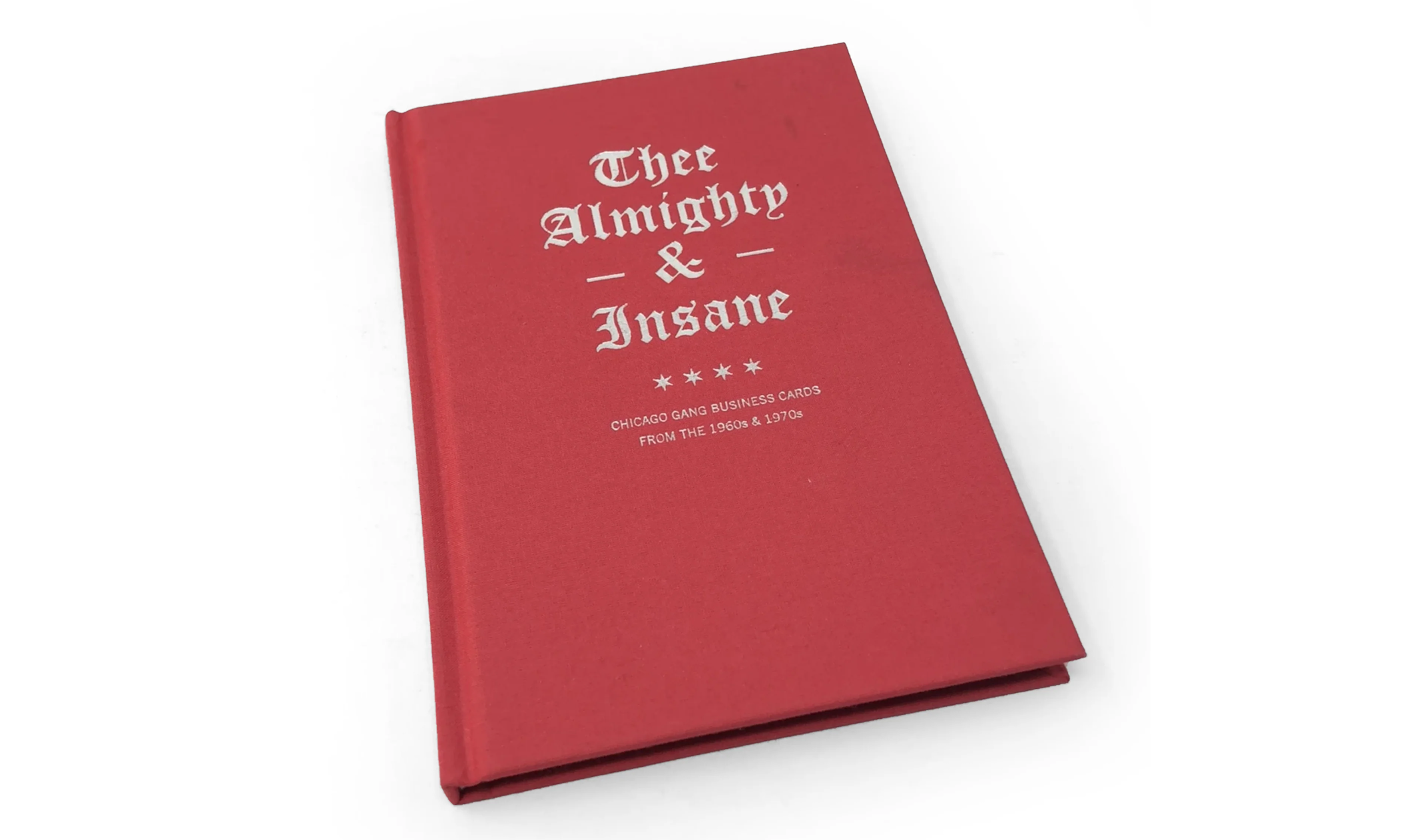Back in the days, the compliment card occupied a rarefied space, one of status and style with just the right touch of intimacy between new acquaintances. A throwback to the Victorian era on both sides of the pond, the posh flocked to local print shops to create their own customized look. The fashion caught on with the masses and production prices dropped, driving high society to declare them hopelessly passé.
Over a century later, a version of them endured on the streets of Chicago during the 1960s, ‘70s, and ‘80s, adopted by the vast network of local gangs as status symbols. “What many people identify as the first compliment card was made by the Gaylords back in the late ‘50s when they were a social athletic club that was transitioning into a street gang and they had membership cards,” says Brandon Johnson, publisher of Thee Almighty & Insane: Chicago Gang Business Cards From the 1960s & 1970s, a hypnotic collection of more than 70 cards from a bygone era of street culture.

Organized geographically, the book maps the city from south to north, creating an impromptu census of the underground as designed by the teens who announced their set, members, and territories with the perfect blend of panache and insouciance. Gangs like the Almighty Playboys, Satan Disciples, and Insane Spanish Cobras, who used these discreet slips of paper to rep their set, recruit new members, and stunt on their enemies with bravado. “Death Before Dishonor” the Almighty Little Harrison Gents of 26th Street proudly proclaimed while the Latin Kings announced “King to the Bone / Never Turn Stone” with crown and cross. The Imperial Toker’s joyously bragged, “We Don’t Die / We Only Get High!” while the Party People let it be known they were “Drinkers Lovers Fighters.”
“As teenagers, how they appear socially and the identity they’re projecting on the streets is important to them,” says Johnson, who first happened upon a card from the Royal Capris in an old cigar box amid his father’s things. On the card the illustrious Playboy Bunny stood at the ready with a pair of dice nearby, courtesy of Jester, Sylvester, Cowboy, Hooker, and Lil Weasel. Johnson’s father got it from a friend back in high school that made them in graphics art class, a junior member of the Royal Capris who was doing his part for the team.

The 1960s and ‘70s mark a period between present and past as the government practice of eminent domain systemically decimated Black, Latino, and white working class neighborhoods across Chicago under the guise of “urban renewal.” Vulnerable communities were systemically displaced, their businesses shuttered and homes razed, pushed into areas where they weren’t welcome and left to fend for themselves. As the ‘60s wore on, the city was rocked by state-sponsored violence, with massive riots during the Long Hot Summer of 1967, the assassination of Dr. Martin Luther King Jr. and the 1968 Democratic National Convention. The following year saw the Trial of the Chicago 8 (later 7), and brutal execution of Fred Hampton, Chairman of the Illinois chapter of the Black Panther Party.
The macro changes to the nation could be felt on the streets, the compliment cards mapping this era of local history as gangs took shape. “They’re a lens to see the bigger dynamics of the era, things like white flight, demographic change, and migration,” Johnson says. “The neighborhoods were changing. The territories being claimed were ethnically related and the gangs were formed to defend themselves from getting bullied at school and on the street. They were trying to keep their neighborhoods safe. The Vice Lords started out like a street gang and transitioned into a community organization in the vein of the Black Panthers. Then crack hit and everything changed.”

Monticello & Wilson Freaks compliment card, courtesy of Almighty & Insane Books
With the arrival of crack, the compliment cards fell by the wayside; in retrospect they look like a RICO case waiting to happen. But with the passage of time, the DIY ethos of the era casts a striking glow around these tiny pieces of ephemera, which the book so eloquently preserves. With Thee Almighty & Insane, Johnson lets the cards speak for themselves, allowing viewers to revel in the pleasures of entrée into this rarified world as crafted by the very participants themselves.
Come for the classic blend of Old English fonts, Maltese crosses, Scottish lions, American eagles, and Skull & Bones; stay for the unexpected discoveries like the handwritten cards rendered lovingly in ballpoint ink. Cast your imagination of a bygone era when Mr. Tarzan got top billing on a Villa-Lobos Nation card, or when Phantom, Mustang, an Styx ran with Thee Almighty Night Crew Association Latin Soul Killers. “Our Dynasty Will Never Perish” the Mighty Nation of Lawndale Gaylord promised in all caps — and indeed these cards keep their legacy alive long after the members have passed.

Latin Kings compliment card, courtesy of Almighty & Insane Books
You can follow Miss Rosen on Twitter






